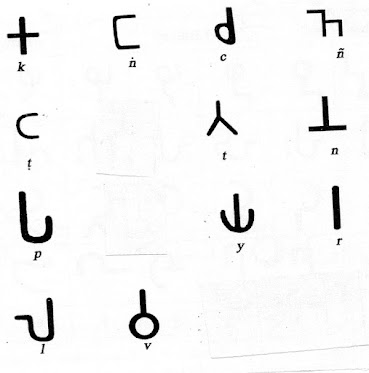As for the consonants, the original ones appeared to be just 12 as follows.
However, these 12 letters changed over to the 18 consonants (given below) as the language grew.
It can be seen that the letters ண் and ன் are derivations from ந். Likewise ம் is from ப். The letter ள் is from ல். The letter ழ் is obtained through a three-stage development from ள். The first stage converts the horizontal-vertical stroke of ள் into a closed curve. In the second, a dash is added to the top of ள். In the third, the whole letter is rotated counter-clockwise to get the present shape of ழ். Further, the hard alveolar letter ற் appears to be a blend of ட் and த் just one above the other. Even in colloquial use, ற் is pronounced either as ட் or த். Perhaps the alveolar ற் and ன் developed so late that they are placed at the end of consonantal series.
Further to these modifications, a vertical-horizontal stroke combination is added in 6-10th century CE to 6 consonants, viz., க், ங், ச், த், ந் and ர். Likewise, a starting chuzhi was added in the 6th century CE to ஞ், ண்,ல்,ள் and ன். All these developments were due to extensive writing in palm-leaves and inscriptions in the resurgent Pandiya and Imperial Chozha reigns. From a typological angle, serif-writing never developed in Tamilnadu. Also thick-thin writing did not develop because of the non-use of brush and paint. The present way of Tamil writing is mainly due to the use of sharp iron-stylus on palm-leaves. The historical development is shown in the table given below.
As for historical development of consonant-vowels, vowel-signs were attached to bases variously to the right, left, top or bottom. In the figure given above to explain the design principle, a dotted square represents a consonant base. Maximum possible design arrangements with 2 dashes at the maximum are 15.
Of these 15, only the first 10 and the 13th design were adopted in Thamizhi and the rest were not used. These designs were not developed a priori, but obtained gradually through trial and error. Initially, there was vacillation and ambiguity in assigning letter values to the first three designs.




2 comments:
அருமை ஐயா. தொடருங்கள்.
சிறப்பு :)
Post a Comment